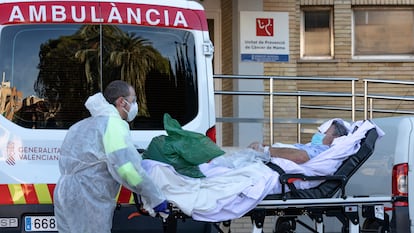Spain reports 9,387 Covid-19 deaths in February, the highest monthly figure since the first wave
The epidemiological situation, however, continues to improve, with the 14-day cumulative number of coronavirus cases per 100,000 inhabitants at 218, under the ‘extreme risk’ level of 250


The epidemiological curve in Spain is still falling, but this third wave is leaving behind significant damage: February is now the month with the highest number of Covid-19 deaths since the first wave of the pandemic last spring. And that is with three more coronavirus reports still to come from the central Health Ministry before the month is out.
According to the latest figures, released on Wednesday evening, there have been 9,387 Covid-19 deaths in Spain in February so far, with 389 added to the overall death toll in the last report.
The good news is that the 14-day cumulative number of coronavirus cases per 100,000 inhabitants came in at 218, having fallen below the “extreme risk” level of 250 earlier in the week. All of Spain’s regions, apart from Madrid, the Basque Country and the North African exclave cities of Ceuta and Melilla, are now under that 250-case level according to Wednesday’s report.
According to the latest report, 30% of ICU beds are occupied by Covid patients (3,241), and in some regions it is over 44%
As has been seen in the previous waves of the health crisis, during this third spike it was infections that rose first, due to socializing over the Christmas period, then hospital admissions, followed by increased occupation of intensive care unit (ICU) beds, and finally a rise in the number of deaths.
According to the ministry’s figures, 873 people have died after testing positive for Covid-19 in the last seven days, while the total death toll since the outset of the pandemic now stands at close to 68,500. This does not include, however, the thousands of fatalities that went untested in the first wave.
February has now outstripped November in terms of the death toll – that month, in the midst of the second wave, saw 9,191 victims. The worst month, however, continues to be April, during the first wave, when there were around 15,500 fatalities. At that time, it should be pointed out, the statistics and reporting were not as well-honed as they are now.
Despite the bad data in terms of victims, the situation is improving throughout Spain. Extremadura, with 87 cases per 100,000 inhabitants over 14 days and the Balearic Islands, with 101, are the regions where transmission is most under control. The areas that are still at maximum alert levels are the North African cities of Melilla (458) and Ceuta (311), as well as Madrid (339) and the Basque Country (274).
Despite the falling curve, Health Minister Carolina Darias called on Wednesday for caution. “In the last four weeks, there has been a very fast fall in the incidence over the last four weeks,” she said at a press conference yesterday. “This rapid fall has been uneven and there is also a reduction in the speed of descent. The average daily fall is 7% but this varies from region to region.”
In fact, Catalonia is one of the regions where the trend is about to take a turn. The speed of the propagation of the virus, known as the R number – i.e. how many people a positive case infect on average – has once again risen above one, which is the limit that the health authorities have established to consider the pandemic under control.
The fall in cases in the northeastern Spanish region has been slowing down for some days now, and is threatening to increase once more. “It is the British variant that is constraining us the most,” said Clara Prats, an expert in mathematical epidemiology at the Catalan Polytechnic University. “We don’t know how it is going to behave.” She was referring to the more-infectious strain first detected in England and known as B.1.1.7. This variant is thought to be circulating in Spain but the country’s limited genetic sequencing capabilities are hampering efforts to track this and other new strains.
We know the consequences of previous deescalations that were carried out in an abrupt mannerHealth Minister Carolina Darias
Meanwhile, in the Canary Islands the fall in infections has also slowed down, and the 14-day incidence has actually risen slightly, from 108 on Monday to 111 on Wednesday. Transmission also crept up in Melilla this week, while the curve is falling slower in Navarre and Cantabria, for example, compared to the average.
The health minister predicted yesterday that the fall in the curve will continue in Spain, but it will be uneven from region to region. She repeated her call for prudence when it comes to the deescalation of the current restrictions in place. “We know the consequences of previous deescalations that were carried out in an abrupt manner,” she warned.
The situation in the country’s hospitals continues to be serious across Spain, and a new spike in cases would be dangerous for the health system. According to the latest report, 30% of ICU beds are occupied by Covid patients (3,241), and in some regions, these high numbers are persisting over time. In Madrid, for example, ICU occupation is over 44% while in Catalonia and Castilla y León it is around 40%.
English version by Simon Hunter.
Tu suscripción se está usando en otro dispositivo
¿Quieres añadir otro usuario a tu suscripción?
Si continúas leyendo en este dispositivo, no se podrá leer en el otro.
FlechaTu suscripción se está usando en otro dispositivo y solo puedes acceder a EL PAÍS desde un dispositivo a la vez.
Si quieres compartir tu cuenta, cambia tu suscripción a la modalidad Premium, así podrás añadir otro usuario. Cada uno accederá con su propia cuenta de email, lo que os permitirá personalizar vuestra experiencia en EL PAÍS.
¿Tienes una suscripción de empresa? Accede aquí para contratar más cuentas.
En el caso de no saber quién está usando tu cuenta, te recomendamos cambiar tu contraseña aquí.
Si decides continuar compartiendo tu cuenta, este mensaje se mostrará en tu dispositivo y en el de la otra persona que está usando tu cuenta de forma indefinida, afectando a tu experiencia de lectura. Puedes consultar aquí los términos y condiciones de la suscripción digital.
More information
Últimas noticias
Maduro pleads not guilty before the federal court in New York: ‘I am still the president of Venezuela’
A new test can detect Alzheimer’s from a finger prick
UN team enters Sudanese city of El Fasher after paramilitary massacre: ‘It’s like a ghost town’
A recipe for resistance: Indigenous peoples politicize their struggles from the kitchen
Most viewed
- Gilles Lipovetsky: ‘If you want to live better and fall in love, take Prozac, don’t look to philosophy’
- Alain Aspect, Nobel laureate in physics: ‘Einstein was so smart that he would have had to recognize quantum entanglement’
- Alvin Hellerstein, a 92-year-old judge appointed by Bill Clinton, to preside over Maduro’s trial in New York
- Why oil has been at the center of Venezuela-US conflicts for decades
- Maduro’s downfall puts China’s relationship with Venezuela to the test









































